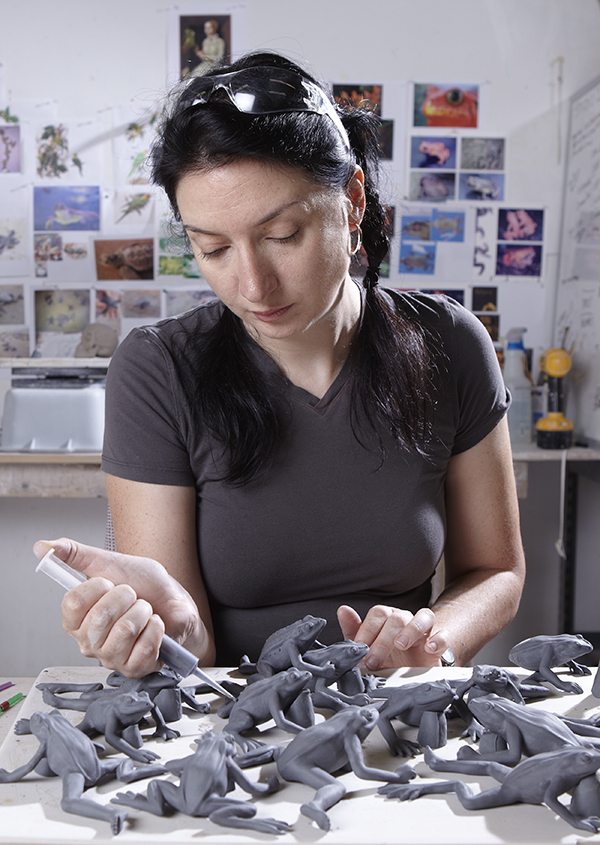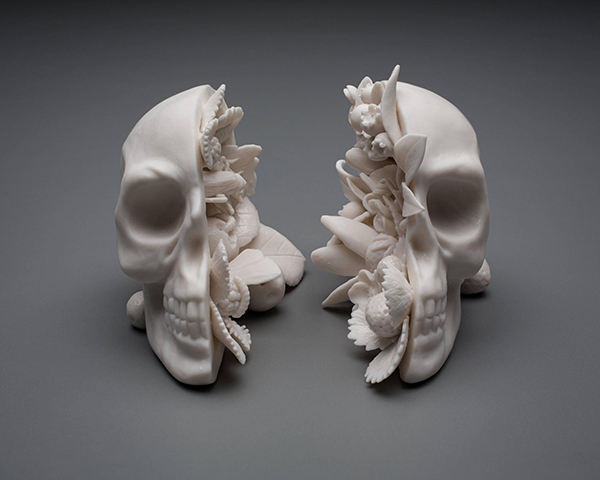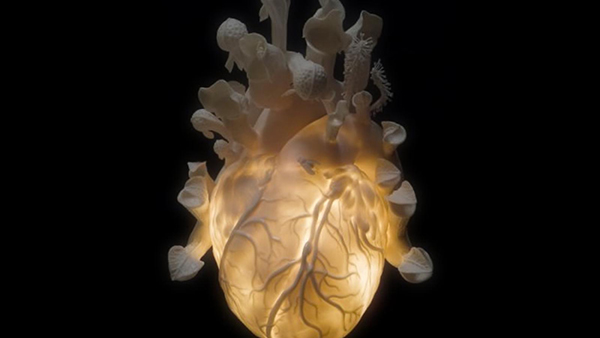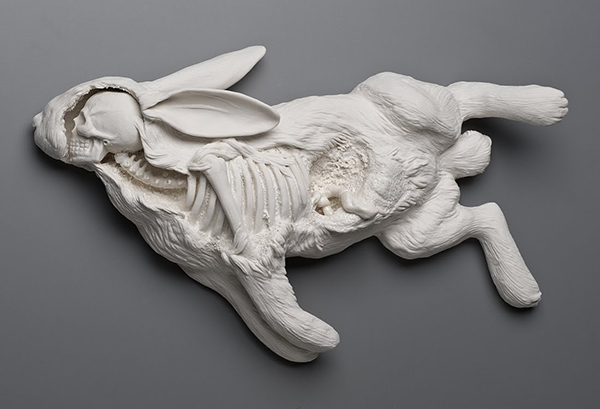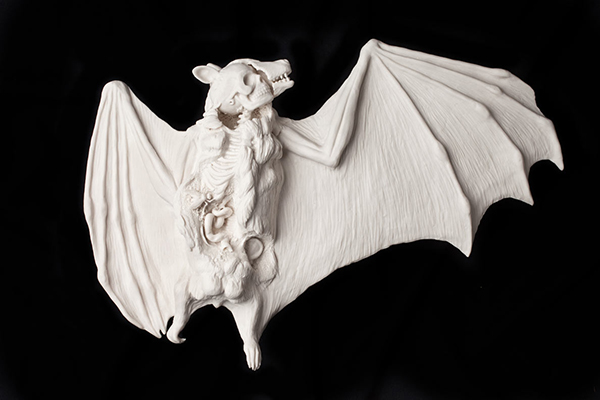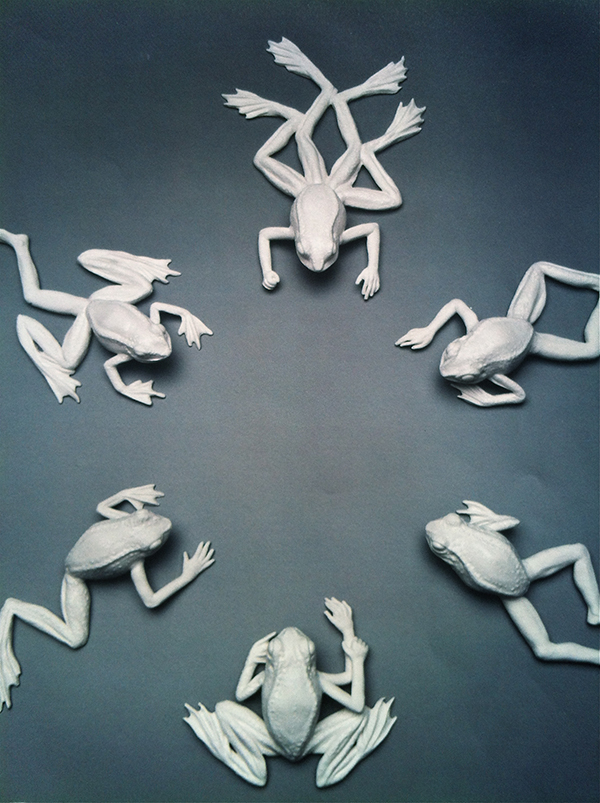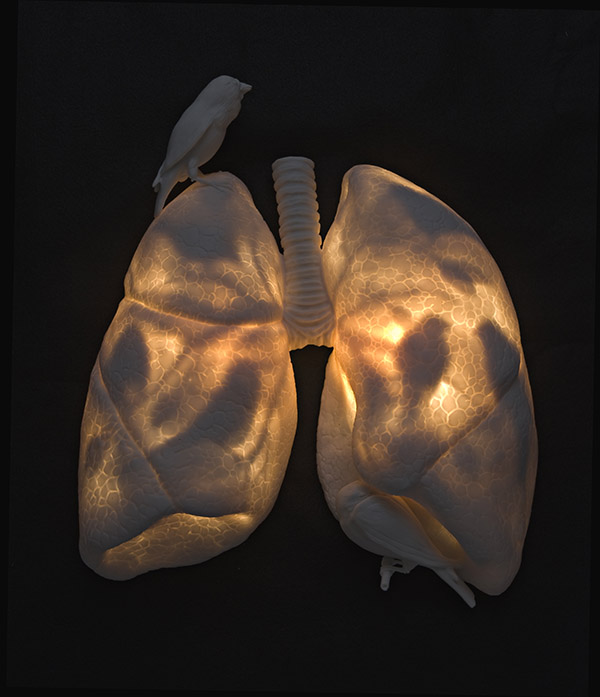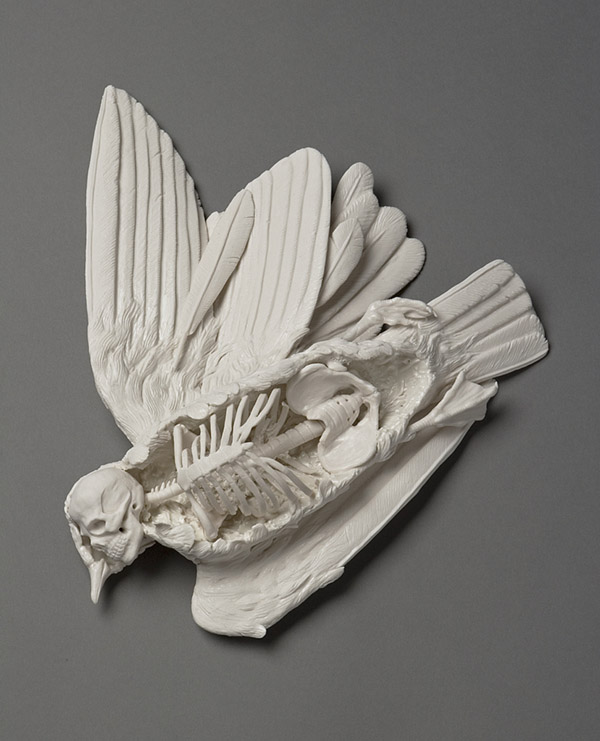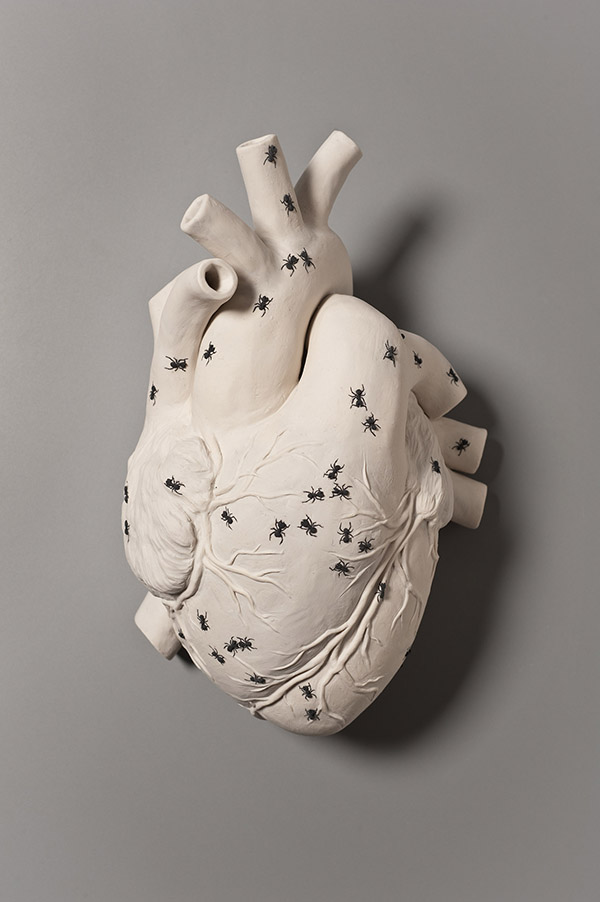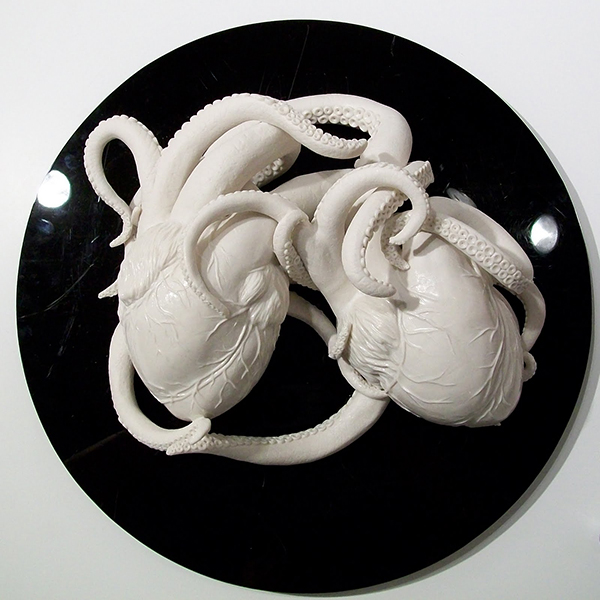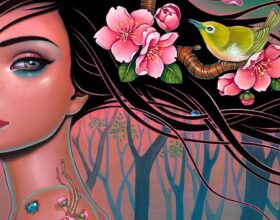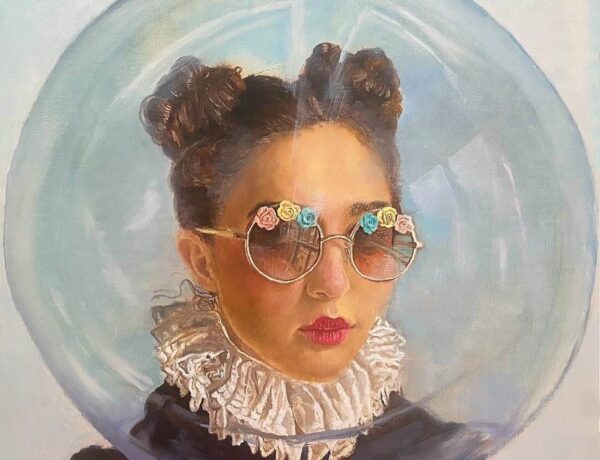Her stoic white sculptures have a conceptual movement that captures the imaginations of many. Kate Macdowell is an artist working in the traditional medium of ceramic in non-traditional ways: lending ears to mice, gas masks to rabbits, and human skeletons to a slew of animal life. She is represented by the Mindy Solomon Gallery of Miami, Patrajdas of Utah, bo-lee Gallery of London, and the Vanessa Quang Gallery of Paris. Kate was kind enough to be interviewed for Issue 016 of beautiful.bizarre.
Web | Facebook | Instagram | Twitter
Justine: Our readers would love a look into your artistic background. Where did you grow up, and how did sculpture come into your life?
Kate Macdowell: I grew up in Columbus Ohio and studied the visual arts heavily in school, but focused on English Literature in college and teaching after graduation. I did once teach a middle-school class on making 7 ft tall papier-mâché dragons, though.
Several years ago I moved to India to work. Seeing how closely the arts were intertwined with daily life and religion in India and Italy, where I spent several weeks as well, and how they played a vital cultural role caused me to recommit to art making again. When I returned to the States I signed up for a ceramics class at a local art center and immediately fell in love with the possibilities of the material. I’ve also experimented with 2-d work, photography and film-making, but 3-d work seems to come most easily to me.
Many of your works display a preoccupation with that which is inside, as well as the fragility of life in general. Why does death, and the internal aspects of physical and emotional life, attract or inspire you?
I’m very interested in our emotional connection to the natural world and how for many of us that impacts our sense of identity. I’m also interested in the conflict between this emotional link and our destructive physical impacts on the environment. This leads to pieces which explore the idea of species extinction and connect it to a warning about our own mortality (as memento mori or vanitas paintings did). I use the conflict caused by the pairing of beauty with the macabre or grotesque in my work to evoke an, often conflicted, emotional response so that viewers will spend more time with the piece.
Do you consider yourself to be an ecowarrior or political artist? Is it important to you to use your art to make a statement?
I feel it’s important for me to be politically engaged as an individual, but making art is sometimes political and sometimes explores much more personal and aesthetic issues(although they can of course overlap). I grew up in a family of activists and environmentalists and coming to my own acceptance that committing to art-making for its own sake had value, aside from its political utility, took a bit of time.
For me the impetus to make a piece of art often has to do with an ecological case study, so it’s important to me as part of the process, but I want the pieces once created to be open to a much broader range of interpretation. As I’m sculpting a piece I sometimes understand it in newer or deeper/more mythic ways, and feel like I’m having a dialogue with the animal or person I’m creating. I particularly like it when viewers share their own interpretations as I’m more concerned about the emotional impact and empathetic connection they have then any political messaging – though if people ask I’ll tell them about the issues that inspired the piece.
What visuals or artists do you find yourself drawn to and continually inspired by?
Right now mostly photography and cinematography. I like filmmakers like Guillermo del Toro and photographers like Gregory Crewdson who play with the darker side of magical realism, as well as studying the stylistic choices made when creating high-level CGI of the natural world—such as in the new Jungle Book movie, as well as more realistic and atmospheric attempts to capture lost wildernesses on film such as in Terrence Malick’s The New World. The textures and shapes of fur, leaf, scale and feather, especially in motion and interacting with light continually draw me in.
Also scientific illustrations and snapshots of road kill, runway fashion, Alexander McQueen’s sculptural and textural creations, baroque marble tomb sculptures by Bernini. Always animals: in photos, at the zoo, or drawn by Audubon.
Many of your works are flat white, and color is very rarely and very carefully used. Why is this a deliberate choice for you and do you ever plan on using color more often?
I first started working with porcelain partly because of its translucent qualities. When lit from within I could evoke the effect of an ultrasound or x-ray used to look inside a body and instead use it to look inside a mind or soul. I could also refer to classical and baroque marble sculpture, and contemporary tomb sculpture, and draw the viewer’s eye to the form rather the surface colors. A pure white piece also speaks to me of ghosts or negative space–it suggests something missing from the world.
More recently I’m making slip-cast work out of terracotta and vitreous china (an industrial slip) in colors other than white – because the use of a specific color is part of meaning/message the piece has for me. For example I made a piece about the extinction of Costa Rican Golden toads, and used black (which matched the dark soil of their habitat) to indicate the ‘missing’ or ‘extinct’ toads, and the bright orange of the males during mating season to indicate the sole survivors.
What is the porcelain process like? How do you keep track of your ideas and how long does a piece take to complete?
I usually have a picture of the finished piece pop into my head, usually with a title, while hiking, riding in a car, or otherwise letting my mind wander. I jot down a sentence in a notebook. When I’ve chosen my best ideas, I go online to Google images and collect source pictures of the forms I’m going to be sculpting, from as many angles as possible. I also do a little reading about the environmental issue or case study that has caught my interest to deepen my understanding.
Usually I briefly sketch or make a tiny maquette of the piece, but with very little detail, just working out positioning of limbs, posture, etc. I make sure to find scientific drawings as well as photographs. Skeletal systems are especially good for figuring out proportions. I usually build a piece solid around a ball of newspaper and then cut it open and hollow everything out to 1/4″ thickness. I build small forms like flowers petal by petal, and amass a collection until I’m ready to add them to the larger piece. Until recently I rarely used or made molds although I do pick up texture by rolling clay over little leaves, for example. Often I’m dealing with components such as fly legs that are too small to hold with my fingers. In those cases, I use a tiny paintbrush tip, which the leg will cling to, and touch it into place on the sculpture. It takes about a week to safely dry a piece then another week of firing and patching. Before drying pieces usually take me from a week (for a very small piece) to a month and half to complete.
What is your view on the human connection with nature? Do you have hope for human life living harmoniously on earth without overusing resources and destroying its natural beauty? Are we becoming more informed, and better equipped for a better future?
I create pieces spurred on by my own feelings of nostalgia. This word was coined by Australian philosopher Glenn Albrecht in 2003 to describe the palpable sense of dislocation and loss that people feel when they perceive changes to their local environment as harmful. It’s a form of psychic or existential distress caused by environmental change, or a homesickness you can experience while at home.
I think people who do feel a connection with nature are often informed about their immediate environment, but political will is another thing, and requires constant battling. I find hope in the recovery of certain species and the lowering cost of green energy which has begun to make more polluting alternatives less economically desirable. I despair when looking at the larger global picture and an unforgiving timeline.
What does the future hold for you? Are there any artists you would like to collab with or mediums you hope to work with?
I’d like to hopefully experiment more with scale and both indoor and outdoor installations. I’d also like to continue to work with photographers outside of a studio setting. I’m interested in exploring a wide variety of applications for my images from wearable art to outdoor public art to claymation videos. I’d love to collaborate with other sculptors or prop-makers working with metal or man-made materials as well as film-makers and clothing and jewelry designers.
Take a look at Kate at work below.


